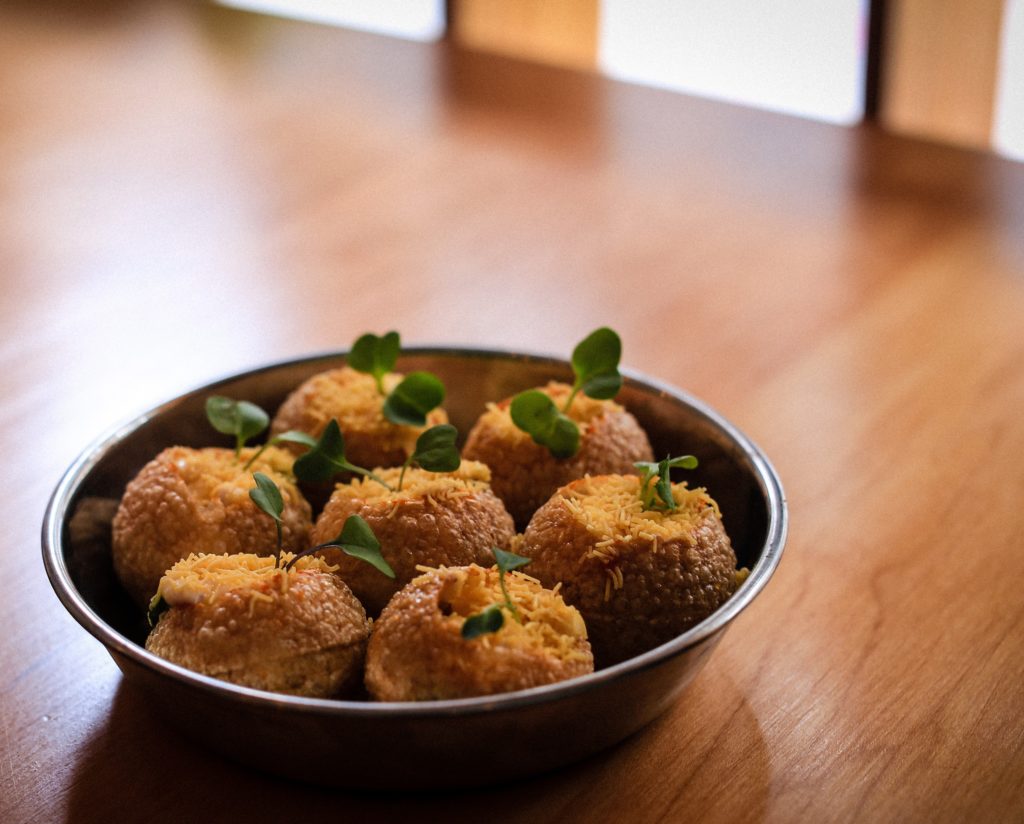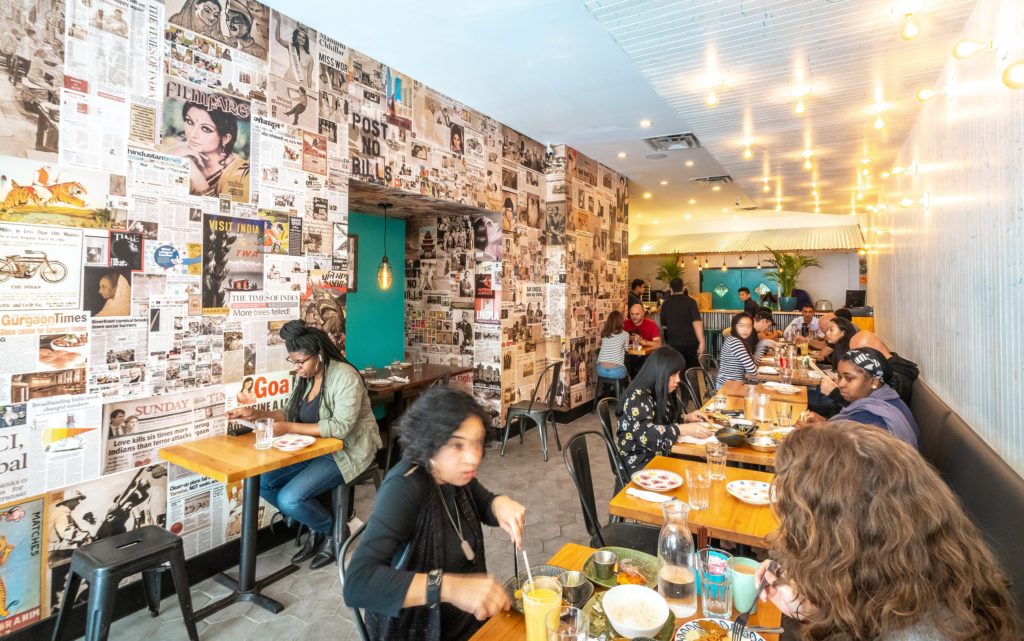7009 people reached on Lassi with Lavina FB page – 25 Likes – 375 post clicks
Shaily Dadiala, Lakhinder Jit Singh Vohra and 7 others like it on Lassi with Lavina FB page

Photo by Noah Fecks

The American Search for ‘Real Indian Food’ leads to Adda Indian Canteen
‘[dropcap]A[/dropcap]dda’ means a hangout in Hindi and New York’s Adda India Canteen is exactly that – a small homey place in an industrial neighborhood in Queens, next to a 711 and set close to a rumbling overhead subway track, small businesses and a community college in prosaic Long Island City, away from Manhattan’s frenetic dining world.
Yet Adda has become the culinary world’s darling. Every night it’s packed and with people still waiting to get in. Rarely has there been such a love fest – many from Manhattan and neighboring states who have never stepped into the borough of Queens are trekking out on a pilgrimage to try Chef Chintan Pandya’s food.
Every mainstream media has raved about the food, and Adda is on every major list including NY.com’s 1000 Best Restaurants, CNN’s best New Restaurants and Timeout’s Best Dishes. As Pete Willis in The New York Times wrote, “Adda is a lusty, full-throated defense of traditional cooking.”
The dishes which are drawing the crowds in include Masaledar Lipatwan Chicken, Tawa Kaleji, Bheja Fry, Tandoori Macchi, Tandoori Poussin, Rara Gosht, Junglee Maas and Lucknowi Dum Biryani. There are also vegetarian offerings like Lotus Root Koftas, Bismal Saag and home-made Paneer khurchan.

[dropcap]S[/dropcap]o what is happening? I went in to check for myself and found it was so packed that dinner reservations had to be made a week ahead – yes, Manhattan had discovered this Indian Canteen and one had to get into line! Adda is a small casual cafe with a color collage wall of Indian newspaper front-pages; while it waits for a liquor license, patrons can bring in chilled beer from a nearby 711 store. It’s moderately priced and serves also local businesses and the students from La Guardia College.
Check out the Biryani!
I met with Roni Mazumdar who owns the modern Indian restaurant Rahi as well as the new kid on the block Adda in partnership with Chintan Pandya who is the executive chef at both these very different restaurants. I had a long chat with Chef Pandya to find out what’s behind this American love affair with unabashed Indian spices, authentic desi food and yes, Indian chilies.
And that, I found, is indeed the magic selling point of Adda’s food. It is authentic Indian. No fancy airs, no modernist pretensions, no dramatics in the menu – just regular food that regular Indians eat at home. Adda’s mantra is ‘Unapologetically Authentic’ and spice is truly the spice of life. There is no playing to the mainstream with a watered down version of ‘Indian cuisine’ – or spicing down of the food for the American palate.

[dropcap]P[/dropcap]andya was born in Ahmedabad where his grandparents’ home is and grew up in Mumbai. He got to eat many different foods at the homes of school friends, and that’s where he got his lessons in how pan-India really eats. He recalls, “We never cooked meat at home but I had lots of friends from Maharashtrian and Muslim households and I got exposed to dishes such as tawa kaleji and bheja masala. People in New York think these are a delicacy here but it was never a delicacy in our country. We used to eat every part of the meat – meat was always on the bone and even here we don’t do it boneless. All our four non-vegetarian kebabs are on the bone, as in Delhi.”
His career took him for training to many Oberoi Hotels from Mumbai to Kolkata to Jaipur and Delhi and in varied cities across India he experienced the way local people ate. He came to the US after working in a restaurant in Singapore and worked in Cleveland and Atlanta before Junoon in New York for a year. He’s been in New York City only about two and a half years but observes: “This city has every kind of food but no one has concentrated on home-style food. You don’t eat Navratan Korma every day at home, you don’t eat Chicken Tikka Masala at home every day but you do make a lamb curry at home every day –– one household could make a Punjabi lamb curry while another would make Hyderabadi lamb curry.”
He recalls that when Adda opened, people questioned that why there was no Vindaloo and Chicken Tikka Masala but they have stayed away from commercialized dishes. He says: “People accept you when there is honesty in your food. It’s not a mishmash.” Whereas most Indian restaurants alter the spice level in deference to the customer, Adda does not. Says Pandya, “If your mother made a lamb curry at home, did she make one spice level for you and another spice level for your brother? There was only one lamb curry made at home and everyone ate that. Spice is a very subjective matter. We are unapologetic about our Indian food.”

[dropcap]P[/dropcap]andya likes to cook what he likes to eat – all the non-commercialized home dishes such as Bismal Saag which is very different from the standard one served in most restaurants, depending on varied local produce: He recalls, “My mother would pick up whatever greens she could get and sauté it for me – that is what I crave for and it’s the cheapest dish on the menu.” Nor does he like to do a generic curry sauce and serve it on paneer, chicken and lamb but creates a special symphony of spices for each dish. He says, “What we are doing is how things are made in India.”
The chef also believes in utilizing local products – such as kale in the traditional pakoras. He points out that in India entertaining is very informal where uninvited friends just drop in and it is essential to feed them something – pakoras are the traditional go-to snack because onions and potatoes are staples in every household. In New York, kale is equally easily available, and the full flavor of these pakoras comes with a good dousing of home-made chatnis and sweet yogurt which give this dish its punch, once again a lesson learned from his mother. For Pandya, the word ‘generic’ is not in his dictionary and all his chaats have their own unique flavor as with the street-vendors of different Indian cities.
Again, the portions are pretty big compared to what’s generally served in New York restaurants. He says, “People say the portions are big but we wanted to give value. This is the way the portions are in India. Also, I feel we have to give people what they really want. Tandoori fish was not in the opening menu until someone from Mumbai mentioned that he really missed eating a whole pomfret on the bone here. It got me thinking – no restaurant had it so I decided to put it on the menu.”

[dropcap]P[/dropcap]andya also brings his own idiosyncrasies into the food, which makes for some offbeat layering – such as Amul cheese. “If you ask me what comes to my mind when you say cheese I would say ‘Amul!’As a kid I just loved Amul cheese. I love cheese in everything and add it to kebabs, just like you always want melted cheese on a burger patty.” So when you order tandoori cauliflower at Adda, you find it is laced with Amul cheese, taking you back to your Indian childhood.
The dishes might be complex in their spicing but things are kept simple and homelike, and often quirky, at Adda. For instance, there’s only one dessert, and it’s not always available. It’s made a few times a week in small batches, and when it’s over, it’s over. “The beauty of the rice khirni is it’s just milk, sugar and rice and garnished with pistachios and cashews but it takes six hours to make – it is something which your grandmother might make.”
Roni Mazumdar and Chintan Pandya are planning a third restaurant soon but each time they plan to explore different spectrums of Indian food, and sometime in the future they also hope to do a specialized seafood restaurant. Pandya, who is frustrated by the fact that many people identify Indian food with just chicken tikka masala, says: “My dream is in ten years to get Indian food on the map where people respect and honor it the way it should be.”
Chicken Biryani by Chef Chintan Pandya from Adda
Ingredients:
8 Tbsp. Yogurt
1 Tbsp.Green chile
Tbsp. Ginger
1 Tbsp. Mint
4-5 thinly sliced onions
1 1/2 cups cream
2 pounds of boneless chicken
1 bay leaf
1 tsp cloves
1 cinnamon stick
6 ounces of clarified butter
1 tsp. mace
2 Tbsp. Jeera black
1 tsp saffron
2 Tbsp. green cardamom powder
1 tsp mace powder
1 lb basamati rice
2 Tbsp. rooh kewra (liquid)
Salt to taste
3 ounces of oil
2 Tbsp. ginger garlic paste
1 tsp.
Instructions:
Clean and cut the chicken. Heat oil, whole spices in a handi and let them crackle. Add onion and cook till light golden color. Add chicken and sauté nicely. Then add turmeric, green chilies, coriander powder, salt and saute for 2-3 minutes. Then add ginger , garlic paste and saute again for another 5 minutes. Add yogurt and saute till oil separates. Add stock and cook further. Once the chicken is cooked 75%, discard whole spices. Add cream, saffron, cardamom and mace powder (strain) and cook further till meat is tender. Soak the rice for half an hour. Boil water and cook the rice to 60% and strain. Now layer the rice and chicken in a copper pot with fried onion, ginger julienne, green chilly julienne, chopped coriander, and chopped mint. Top it with saffron, cream, ghee, cardamom and mace powder. Cover with the naan dough and bake it. Serve it with raita.
